|
|
|
Sort Order |
|
|
|
Items / Page
|
|
|
|
|
|
|
| Srl | Item |
| 1 |
ID:
096394
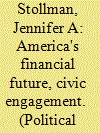

|
|
|
|
|
| Publication |
2010.
|
| Summary/Abstract |
Institutions of higher learning reflect the philosophies, environments, and resources of their location. Fort Lewis College sits in the San Juan Mountains, a part of the Rocky Mountain chain in southwest Colorado. Throughout its history, the College has successfully transformed itself to suit the needs of its students. Flexibility is demonstrated in frequent changes in focus, curriculum, student population, and programming. Founded as an agricultural high school in 1911, the College transitioned to a two-year college in 1927, implemented an agricultural and mechanic two-year degree program in 1933, assumed junior college status in 1948, and finally, in 1962, became a baccalaureate degree-granting institution that centered its educational objectives around a liberal arts philosophy. Additionally, the College's diverse faculty and student population impact the curriculum and programs. Students of differing classes, ethnicities, regions, and faith traditions share intellectual and physical space. Presently, the student population is just under four thousand, and there are approximately two hundred tenure or tenure-track faculty. Eighteen percent of the student population is native, representing over 125 different nations, but principally the Navajo nation. These statistics require the College to adjust its curricular objectives to suit the intellectual levels and goals of its students.
|
|
|
|
|
|
|
|
|
|
|
|
|
|
|
|
| 2 |
ID:
096388
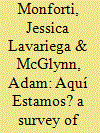

|
|
|
|
|
| Publication |
2010.
|
| Summary/Abstract |
The breadth of material covered in introductory U.S. government and politics survey courses creates a situation in which the textbooks used may serve as the primary source of information students receive about the country's political system. At the same time, their content represents a conscious choice by the authors, editors, and publishers of these textbooks regarding what topics and content are necessary and worthy of publication, which socializes students to accept particular viewpoints of the formation and operation of the U.S. government. Oftentimes, the information presented in textbooks across subdisciplines ignores the political experiences and influence of racial, ethnic, and other minority groups. We test this premise by engaging in a study of 29 introductory U.S. government and politics textbooks to assess the level of coverage and treatment of Latinos/as, the fastest growing racial/ethnic group in the country. We find that the discussion of Latinos in these textbooks is incredibly brief and often limited to the civil rights chapters. Furthermore, Latinos are primarily mentioned in the discussion of immigration, while their overall contributions to the political development of the United States are largely ignored.
|
|
|
|
|
|
|
|
|
|
|
|
|
|
|
|
| 3 |
ID:
096375


|
|
|
|
|
| Publication |
2010.
|
| Summary/Abstract |
From the establishment of the United States Postal Service and the invention of the telegram, to the introduction of C-SPAN and the explosion of the Internet, the development of new communication technologies has always affected the functioning of Congress. Not surprisingly, recent innovations such as e-mail and social networking have spurred Congress to alter the way it operates as an institution, and rethink the manner in which it engages the public. In this brief examination, I discuss recent changes in congressional behavior and practices due to technological innovation, specifically the proliferation of social networking Web sites. Then, I cautiously predict future trends in the use of social networking and related technologies as they become more integrated in congressional offices and increase the capacity for more robust internal and constituent communications over time.
|
|
|
|
|
|
|
|
|
|
|
|
|
|
|
|
| 4 |
ID:
096393
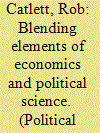

|
|
|
|
|
| Publication |
2010.
|
| Summary/Abstract |
I don't think I am good enough" was more than one student's response when invited to participate in civic engagement activities or to articulate their own original scholarly ideas. The insecurities underlying comments like this one are probably much more complex when put into the context of a student's academic life and its normal expectations. Students may have heard about previous civic engagement ventures from classmates who preceded them, and admittedly, many of those students had similar reservations in previous American Democracy Project (ADP) ventures; however, the America's Future Initiative was different. This initiative aspires to engage students' critical and analytical thinking on issues related to deficits and debt, especially in the public sector; furthermore, America's Future is a call to action without a prepared script.
|
|
|
|
|
|
|
|
|
|
|
|
|
|
|
|
| 5 |
ID:
096376


|
|
|
|
|
| Publication |
2010.
|
| Summary/Abstract |
The United States population is changing in significant ways: it is growing larger, older, and more racially and ethnically diverse, and these changes are regionally concentrated. How will these changes affect the future of Congress? In this article, I show that demographic change has significant implications for the quality of representation, the legislative agenda, party coalitions, and the diversity of congressional membership in the future, even as change inside Congress will proceed more slowly than change outside it.
|
|
|
|
|
|
|
|
|
|
|
|
|
|
|
|
| 6 |
ID:
096378
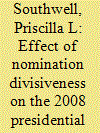

|
|
|
|
|
| Publication |
2010.
|
| Summary/Abstract |
This research examines the effect of disgruntlement among primary and caucus voters who supported U.S. presidential nomination losers-a potentially divisive nomination process. I analyze the general election voting behavior of primary and caucus voters in the 2008 presidential election to determine if differences exist between supporters of the winning nominee in each party and backers of other candidates who also sought the nomination. A multivariate analysis of the determinants of "loyal party vote" suggests that Clinton and Edwards supporters showed a significantly higher degree of defection in the general election, although this behavior did not occur among people who voted for Romney or Huckabee in their state's primary or caucus.
|
|
|
|
|
|
|
|
|
|
|
|
|
|
|
|
| 7 |
ID:
096387
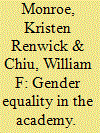

|
|
|
|
|
| Publication |
2010.
|
| Summary/Abstract |
As part of the ongoing work by the Committee on the Status of Women in the Profession (CSWP), we offer an empirical analysis of the pipeline problem in academia. The image of a pipeline is a commonly advanced explanation for persistent discrimination that suggests that gender inequality will decline once there are sufficient numbers of qualified women in the hiring pool. The CSWP believes that it is important to ask whether this phenomenon is actually occurring, because the implication is that we can explain inequality as a function of insufficient numbers of trained women in the pool, rather than as a result of ongoing discrimination that requires alternate remedies. Data from the American Association of University Professors suggests that merely increasing the pool of qualified women has not led to a commensurate number of women rising to the top in academia. Women are still ending up in lower paid jobs, and they continue to earn less than men in comparable positions. More aggressive policies to end discrimination are required.
|
|
|
|
|
|
|
|
|
|
|
|
|
|
|
|
| 8 |
ID:
096397
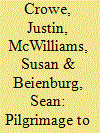

|
|
|
|
|
| Publication |
2010.
|
| Summary/Abstract |
As part of a course considering "American Democracy in Theory and Practice," we took 36 students to Rick Warren's Saddleback Church in Lake Forest, California. During that visit, students observed a community that seeks self-sufficiency and yet proves to be simultaneously responsive to and reflective of American democracy more broadly. Specifically, in a few short hours, they were able to see the virtues of civic association, the difficulty of respecting individualism in large-scale polities, the influence of regional identity, and the two-way interaction between politics and culture-all themes that featured prominently in our course. We offer this reflection to suggest the pedagogical benefits of showing the tensions of American politics in action and to encourage colleagues to consider integrating similar ventures into their own courses.
|
|
|
|
|
|
|
|
|
|
|
|
|
|
|
|
| 9 |
ID:
096380
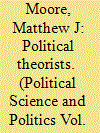

|
|
|
|
|
| Publication |
2010.
|
| Summary/Abstract |
The question of the role of normative or historical political theory within the broader discipline of political science has been controversial at least since the founding of the American Political Science Association (see Gunnell 2006 for a brief overview). Perhaps it goes without saying that during that same period people who think of themselves as engaged in political theory have disagreed among themselves about the core concerns of the field, the appropriate kinds of graduate training, the relative value of various authors and texts, and, of course, about theory's role within political science.
|
|
|
|
|
|
|
|
|
|
|
|
|
|
|
|
| 10 |
ID:
096381
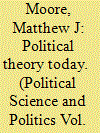

|
|
|
|
|
| Publication |
2010.
|
| Summary/Abstract |
This article reports the results of a 2008 national survey of political theorists. The results, based on 1,086 responses from professors at accredited, four-year colleges and universities in the United States, provide information about the demographic characteristics of political theorists, opinion data on the place of political theory within political science, the proportion of political theorists in political science departments, teaching loads, expectations for tenure, the experience of political theorists on the academic job market, and, finally, rankings of theorists, journals, publishers, professional organizations, and Ph.D. programs.
|
|
|
|
|
|
|
|
|
|
|
|
|
|
|
|
| 11 |
ID:
096384


|
|
|
|
|
| Publication |
2010.
|
| Summary/Abstract |
Matthew Moore's survey and analysis reflect an enormous amount of work, for which all of us who study or teach political theory should be grateful. They offer us a fascinating snapshot of who is teaching political theory today, of how they understand and think about what they are doing, and of how they think others think about theory. Much that is included in his analysis (and especially in the longer paper from which the report here is selected) is well worth further study and debate, as it opens a door to the ways political science in general (and not theory alone) is being taught around the country: what political scientists think they are doing when they/we teach their material, what training they/we have, and even what modal teaching loads are.
|
|
|
|
|
|
|
|
|
|
|
|
|
|
|
|
| 12 |
ID:
096391
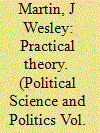

|
|
|
|
|
| Publication |
2010.
|
| Summary/Abstract |
How can philosophical instruction inform practical analysis and decision making among college students in a way that demonstrably benefits them as individual members of our polity and economy? I pose this question because each year, I introduce classic political theory to first- and second-year college students who simultaneously confront a fiscal crisis in the American state and profound financial challenges as individuals, and I want to ensure that the concepts and analytical strategies we study as theory can meet their most pressing practical needs during the first decade that they are out of college.
|
|
|
|
|
|
|
|
|
|
|
|
|
|
|
|
| 13 |
ID:
096386


|
|
|
|
|
| Publication |
2010.
|
| Summary/Abstract |
Scholarly publication in peer-reviewed journals is widely regarded as the road to scholarly success. However, in a diversity of fields such as sociology, economics, and political science, it has been shown that the rate of publication is much lower for women than for men. The question of whether a systematic relationship exists between gender and research methods has also frequently been debated. In this paper, we explore patterns of authorship and scholarship in two influential interdisciplinary journals, Political Communication and the International Journal of Press/Politics, over the last decade. A systematic content analysis was conducted to determine the gender ratio of authors, the methods and theories employed, and the ratio of quantitative to qualitative research studies. In addition, we tracked the use of primary or secondary data sources and the prevalence of research funding by gender. Overall, we find that while women are publishing less than men, their rate of publication is somewhat higher than their representation in the field.
|
|
|
|
|
|
|
|
|
|
|
|
|
|
|
|
| 14 |
ID:
096398


|
|
|
|
|
| Publication |
2010.
|
| Summary/Abstract |
Popular music is ubiquitous in the lives of our students, music is used by politicians at virtually every one of their campaign events, and musicians are increasingly active in politics, but music has never been considered as a pedagogical tool in teaching political science classes. This article describes the use of music in an introduction to American politics class. I argue that playing music in class can increase student interest, reinforce important concepts, and actively engage the students in the learning process. Finally, using popular culture connects meaningfully with the way that many of our undergraduate students are experiencing politics.
|
|
|
|
|
|
|
|
|
|
|
|
|
|
|
|
| 15 |
ID:
096374


|
|
|
|
|
| Publication |
2010.
|
| Summary/Abstract |
Current circumstances might seem to present real opportunities for Congress to reassert itself relative to its weakened role during George W. Bush's presidency. Large, unusually cohesive Democratic majorities in both chambers; unified government; and an administration staffed with people who know Congress well-all this might lead one to expect a productive working relationship permitting Congress wide scope of action. Nevertheless, the Senate's internal deliberative processes threaten to create difficulties so significant that they may outweigh these developments. Looking to the future of Congress, changes in Senate procedures and practices are important not only because of their effects on the institution's internal power structure. Left unchecked, they are also likely to have implications for the balance of power between the executive and legislative branches of government.
|
|
|
|
|
|
|
|
|
|
|
|
|
|
|
|
| 16 |
ID:
096396
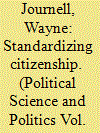

|
|
|
|
|
| Publication |
2010.
|
| Summary/Abstract |
The rise of state-mandated standards in public education have allowed legislators to answer the question of what constitutes a proper civic education, a debate that has existed in the United States since the turn of the twentieth century. Through the content they employ in their standards, states may indirectly influence the type of citizenship education students receive in the classroom. The present study focuses on the Virginia Standards of Learning for two courses, civics and economics and U.S. and Virginia government, which are commonly taught to eighth graders and high school seniors, respectively. A content analysis of the essential knowledge found in the standards for these courses categorizes instructional content into seven forms of citizenship: civic republicanism, character education, deliberative, social justice, participatory, transnational, and cosmopolitan. Although the results are specific to the Virginia Standards of Learning, the nature of how citizenship is portrayed within the standards may transfer to other states with similar forms of standards-based education within their social studies curricula.
|
|
|
|
|
|
|
|
|
|
|
|
|
|
|
|
| 17 |
ID:
096377


|
|
|
|
|
| Publication |
2010.
|
| Summary/Abstract |
Travel, stump speeches, and pressing-the-flesh make up a large part of any presidential electoral campaign. Obviously, candidates feel that their appearances are important, as they make hundreds of appearances between Labor Day and Election Day. But are they right? Well over 100 million people cast ballots in November, but only the tiniest fraction of voters meets or catches a glimpse of either of the candidates. Do candidate appearances and contact sway voters in some way? In this article, we use changes in weekly state tracking polls to determine the impact of candidate appearances in battleground and non-battleground states. Using polling data from the 2000, 2004, and 2008 elections, we find that campaign appearances can change a candidate's polling percentages, and that the impact varies by candidate and location (battleground state, safe Democratic state, or safe Republican state). We also find that the selection of a vice-presidential candidate is important, because of this candidate's ability to campaign effectively.
|
|
|
|
|
|
|
|
|
|
|
|
|
|
|
|
| 18 |
ID:
096383
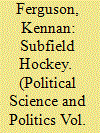

|
|
|
|
|
| Publication |
2010.
|
| Summary/Abstract |
This survey's importance comes not from what it informs us about political theory as a field, but rather from the function it serves within debates over the component areas of the field of political science. Rather than answering whether political theory "belongs" within political science (an unanswerable question), the survey uses quantification of qualitative experience and data collection to consolidate political theory as a subfield. Thus success of this project relies upon and reinforces disciplinary norms, operating as a process that attempts to bring a normative political theory into existence. The rank ordering of departments, journals, and individual theorists proves appealing not only for the competitive, horse-race valuation of those people and institutions, but also for how they ultimately resist this project by showing the anti-normative heart of political theory: an important and useful survey indeed.
|
|
|
|
|
|
|
|
|
|
|
|
|
|
|
|
| 19 |
ID:
096390
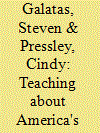

|
|
|
|
|
| Publication |
2010.
|
| Summary/Abstract |
Civic engagement is increasingly recognized as a significant function of public universities. The university provides a variety of opportunities for civic engagement, including co-curricular activities, service learning opportunities, and specific majors and minors. This article reviews the attempt to embed civic engagement and civic education about the national debt and budget deficit issues in a university core curriculum course at Stephen F. Austin State University. We focus on specific issues of curriculum instruction and assessment of student learning of knowledge regarding the debt and deficit issues.
|
|
|
|
|
|
|
|
|
|
|
|
|
|
|
|
| 20 |
ID:
096382
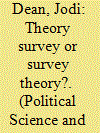

|
|
|
|
|
| Publication |
2010.
|
| Summary/Abstract |
Matthew Moore's survey of political theorists in U.S. American colleges and universities is an impressive contribution to political science (Moore 2010). It is the first such survey of political theory as a subfield, the response rate is very high, and the answers to the survey questions provide new information about how political theorists look when compared to political scientists overall. We are roughly the same age, for example, and are slightly more likely to be female. The survey also gives us a picture of political theorists' conditions of employment: about half of us get jobs in the first year upon receiving our Ph.D.s; most of us teach at schools that range from 1,000 to 10,000 students; most of us are not at Ph.D.-granting institutions.
|
|
|
|
|
|
|
|
|
|
|
|
|
|
|
|
|
|
|
|
|